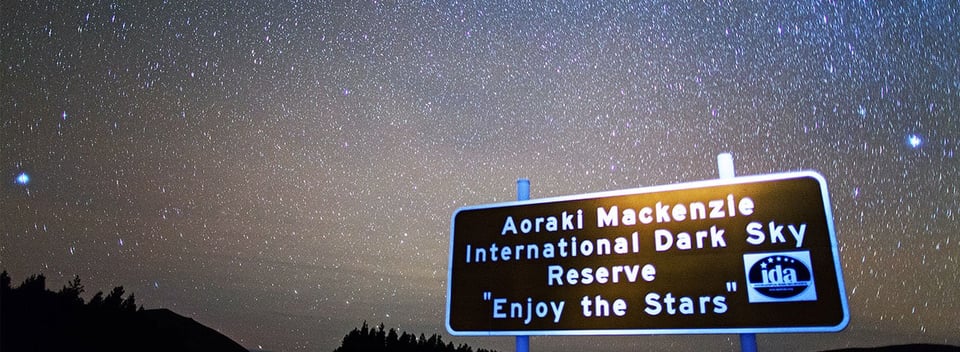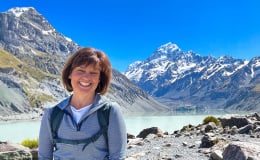
The Best Spots for Stargazing in New Zealand

Come and experience life under the darkest skies in the world! Join us at the ends of the earth where the night sky dazzles and showcases its beauty and fascinating features like nowhere else on earth. Have you ever wondered what lies above you? Well, you might get a slightly different view from this side of the planet if you’re usually a Northern Hemisphere dweller, but let me tell you… you’re in for a treat.
The Best Places for Stargazing in New Zealand
1. Lake Tekapo, Mackenzie Country
Lake Tekapo is a beautiful greeny-blue glacial lake situated in the Aoraki Mackenzie region in the centre of the South Island. It’s famous as one of the best places for stargazing in New Zealand and the views are truly magical. In fact, it’s so important that in 2012, UNESCO designated Lake Tekapo and the surrounding area (4,300 sq km in total!) as the world’s first International Dark Sky Reserve. It even achieved gold status, meaning there is no light pollution at all.
If time allows, we recommend taking a trip to the top of Mt John to visit the observatory where you can use the country’s most powerful telescope to spot up to 50 million stars. Now that’s a whole lot of stars!

Photo credit: Ken Cheung
2. Queenstown
Above the mountains of Queenstown the stars shine more beautifully than anywhere else. To get a closer view of the stars, take a trip to the top of Bob’s Peak on the gondola at night and enjoy your own celestial show.

Photo credit: Joe Leahy
3. Stewart Island and the Southern Lights
If you’re lucky enough to have time to visit Stewart Island, tucked down at New Zealand’s most southerly point, there are treats in store. You’re likely to be out at night listening for kiwis rustling in the forests as it’s the ideal quiet spot to view these incredible nocturnal birds. However, you might be distracted by the Aurora Australis, if you’re lucky enough to see them lighting up the sky – the incredible Southern Lights dancing against the dark night sky. They are identical, if not quite as famous, as the Northern Lights, caused by a collision of atoms and energy-charged particles above the South Pole. You’ll see spectacular visions of green, yellow, blue and purple lights dancing across the sky. The best time to catch them is during the winter months in July or August, but they are sometimes seen later in the year too. Stewart Island is the fifth International Dark Sky Sanctuary and the second Island Sanctuary in the world.

Photo credit: Sandra Whipp
4. Great Barrier Island (Aotea)
Great Barrier Island is an isolated island located in the Hauraki Gulf, north east of Auckland, and a 90-minute ferry ride away from this main city. Unusually, it’s free from the electricity grid and its small resident population means it’s almost completely unaffected by light pollution. It is a designated International Dark Sky Sanctuary and one of only four places in the world to be granted sanctuary status. A dark sky sanctuary is defined as public or private land that has "an exceptional or distinguished quality of starry nights".

Photo credit: Carmen Bird
What will I see in the New Zealand night sky?
When gazing heavenwards clutching your hot chocolate/beer/glass of delicious New Zealand wine after an active day in the outdoors, you’re in for a real treat.
Stars and Galaxies
The southern sky is home to three of the brightest starts in the sky, Sirius, Canopus and Alpha Centauri. It also provides an open stage for some of the best examples of astronomical objects in the universe. On a clear night you’ll be able see amazing views of the Large and Small Magellanic Clouds, two incredible galaxies visible to the naked eye. They are only visible from down here as they are too far south for those viewing from the Northern Hemisphere. The vast swathe of the Milky Way is also clearly visible and is directly overhead during the winter months. Then there’s the most famous constellation of all - the Southern Cross, a clear marker in the New Zealand night sky.
The Southern Cross
The Southern Cross is made up of five stars that belong to a larger constellation known as Crux. While Crux might be the smallest of the 88 known constellations in the galaxy, it’s the most famous group of southern stars out there. Such is its importance and historical significance, it appears on the flags of four nations – New Zealand, Western Samoa, Papua New Guinea and Australia. The kite shaped pattern of four bright stars and one not so bright, called Alpha, Beta, Gamma, Delta and Epsilon, are all within 16 degrees of each other. Over each 24 hour period they journey across the skies around the South Celestial Pole. The pointer stars that help to identify the Southern Cross are called Alpha Centauri and Beta Centauri.

Photo credit: World Atlas
Magellanic Clouds
Two seemingly insignificant puffs of cloud-like consistency appear in the clear night skies over New Zealand and these are actually, believe it or not, two neighbouring galaxies. At a distance of over 170,000 light years away, these two galaxies(known as the Large Magellanic Cloud and the Small Magellanic Cloud) are home to over 10,000 million stars. They are the closest galaxies to our own and viewing them either with the naked eye, binoculars or telescope is a real treat. Interestingly it is thought they are satellite galaxies linked to the Milky Way somehow by gravity. The next closest galaxy is Andromeda, over 2.2 million light years away. Fascinating!
The Milky Way
The Milky Way is the galaxy that contains our own solar system and the view we get from Earth is that from the edge towards the centre of the galaxy itself. Every star we can see with our eyes form part of the Milky Way galaxy, apart from the Large and Small Magellanic Cloud and the Andromeda Galaxy. A fascinating part of the Milky Way is the area that looks like a dark ‘hole’ in the sky, which is actually a cloud of cosmic dust located over 600 light years away, known as the Coal Sack. It’s located very close to the Southern Cross and actually hides from view the stars that are lying behind it.
Here we can see the majestic Milky Way set above the mountains of McKenzie Country, a designated International Dark Sky Reserve, a UNESCO supported initiative created to preserve the quality of the night sky and highlight its cultural, scientific and natural values.

Photo credit: Alex Cherney
Stargazing in New Zealand
Compared to the views from the Northern Hemisphere, the southern skies contain more wonderful features to discover and with our dark skies and limited light pollution, you’ll see so much. Luckily for us, many of the New Zealand night sky features are visible with the naked eye, so there’s no need to lug your telescope along with you in your suitcase. Although if you do want to explore further, there are places where telescopes are available for viewing the depths of our incredible night skies. It’s a world we really could stop and appreciate more often.
The New Zealand night sky is woven deeply into the culture of the Maori people and they relied heavily on the stars for navigation and for other significant events. Matariki, the rise of the Pleiades constellation, signals the start of the Maori New Year.
Anywhere in New Zealand is a good place to see the stars, so you really can’t go wrong. On a clear night you’ll be in awe of the skies above and reluctant to head back inside for bed. If you’re interested in coming to New Zealand and letting the locals show you round, get in touch with Jodi or request a free brochure mailed straight to your door.








Comments
Let’s talk – we’d love to hear what you think. Pop your details in below and have your say.
No one has commented on this page yet.
RSS feed for comments on this page | RSS feed for all comments